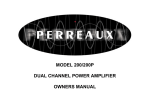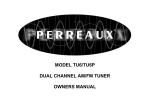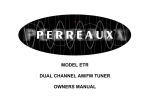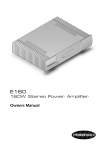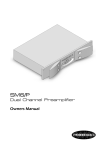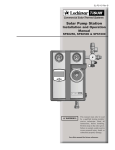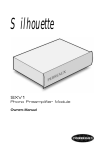Download Perreaux APV1P Stereo System User Manual
Transcript
MODEL AVP1/APV1P DOLBY DIGITAL® DTS® PROCESSOR/PREAMPLIFIER OWNERS MANUAL AVP1/ AVP1P OWNERS MANUAL to understand every detail by familiarising yourself with the controls and features as you read. You will find it easier to install using the relevant sections of this manual as a reference. We have attempted to explain every feature and operational facet clearly and concisely. Your Perreaux dealer will be happy to assist if you encounter any unforeseen problems. Care should be taken to avoid the use of solvents for cleaning particularly on plated Classic series products. Use only a soft cleaning cloth with a mild solution of non caustic detergent if necessary. Non plated Classic series products may be cleaned with a polish designed for use on aluminium. CONTENTS Read this manual, install your AVP1 correctly and realise the sonic significance of your investment in Perreaux. Perreaux products are designed to provide the utmost in sonic realism and electronic reliability with a functional yet elegant appearance, this reflects the care and craftsmanship applied during all stages of construction. To maintain the consistently high quality that you expect from us, and we expect from ourselves, Perreaux products are essentially handcrafted. We maintain the human link throughout, from design and construction, through to the ultimate test, your music, your system, your ears. INTRODUCTION Congratulations on your PERREAUX Model AVP1 purchase. To realise the full potential of your Perreaux AVP1 you need to appreciate all aspects of its operation. Before installing the AVP1 into your system, read the entire manual carefully. Endeavour Because we too listen to our products we know that with your Perreaux you will discover many more of the musical secrets we strive to reveal. Note. All references to Models AVP1P are also applicable to Model AVP1 Classic series product other than the front panel cleaning instructions . Safety Instructions Important Information Front Panel Controls Front Panel Display & Indicators Rear Panel Remote Control On Screen Display (OSD) Getting Started Installation and Operation Precautions Specifications 2 2 3 4 5 7 8 8 8 10 SAFETY INSTRUCTIONS 1. Read Instructions All safety and operational instructions should be read before the AVP1 is operated. Keep the Owners Manual in a safe place for future reference. 2. Follow Instructions All installation, operation and other instructions should be followed. 3. Warnings All warnings on the AVP1 and in the Owners Manual should be strictly adhered to. 4. Water and Moisture The AVP1 should not be used near water, for example near a bathtub, 2 washbowl, kitchen sink, laundry tub, in a wet basement, near a swimming pool, etc. 5. Rack / Wall / Ceiling Mounting The AVP1 should be rack mounted only in a heavy-duty rack or stand that is recommended for audio equipment use. Mounting to a wall or ceiling should be via a heavy-duty bracket or shelf designed for audio equipment use. 6. Heat The AVP1 should be situated away from heat sources such as radiators, stoves, or other appliances that produce excessive amounts of heat. 7. Power Sources The AVP1 should be connected to mains power supply only of the type described in the operating instructions, or as marked on the rear of the AVP1 8. Power Cord Protection The mains power supply cord should be routed so that it is not likely to be walked on or pinched by items placed on or against it. Pay particular attention to the cord at power points, convenience receptacles, and the point where it exits from the AVP1. 9. Cleaning When cleaning any Perreaux product use lukewarm water with a few drops of mild detergent. DO NOT USE SOLVENTS. 10. Non-use Periods The mains power cord of the AVP1 should be unplugged from the mains/line outlet when the unit is to be left unused for long periods of time. 11. Object and Liquid Entry Care should be taken so that objects and/or liquids do not accidentally fall inside the AVP1. 12. Damage Requiring Service Qualified service personnel should service the AVP1 if any of the following occur: a. The mains power-supply cord, and/or plug have been damaged b. Objects have fallen, or liquid has been spilt into the AVP1 c. The AVP1 has been exposed to rain and/or excessive moisture d. The AVP1 does not appear to operate normally, or exhibits a marked change in performance e. The AVP1 has been dropped, or the chassis damaged. performing any switching functions or connection alterations of any type to your AVP1, or to any other part of your entire system. This caution also applies to the normal use of your Laser Disc player, Tuner, Cassette Deck, etc. PRODUCT SUPPLIED WITHOUT MAINS PLUG If your unit comes with a 3-core cable but without a plug, make certain LIVE and NEUTRAL leads are connected correctly to your plug terminals. IMPORTANT: The wires of the mains/line lead in this unit are coloured in accordance with the following code: IMPORTANT INFORMATION BROWN LIVE BLUE NEUTRAL GREEN/YELLOW EARTH/GROUND As the wire colours in the mains lead of this unit may not correspond exactly with those coloured markings on the terminals of your plug proceed as follows: - The wire which is coloured BLUE must be connected to the terminal which is marked with the letter N, or colour coded BLUE or BLACK. - The wire which is coloured BROWN must be connected to the terminal which is marked with the letter P or L, or colour coded BROWN or RED. - The wire which is coloured GREEN/YELLOW must be connected to the terminal which is marked with the letter E, or colour coded GREEN/YELLOW or GREEN. Always make sure the attenuator / volume control of your AVP1 or source unit is set to –80dB and the mains/line supply disconnected from your AVP1 prior to NOTE: Any modifications to the mains/line voltage setting within your AVP1 may only be carried out by a 13. Servicing The user should not attempt to service the AVP1 beyond those means described in the owners’ manual. All other servicing should be referred to qualified service personnel. 14. Grounding or Polarisation Precautions should be taken so that the grounding or polarisation of the AVP1 are correct, and are maintained throughout the entire system. 3 qualified Perreaux service agent. Failure to recognise this warning will void any warranty. 5 FRONT PANEL CONTROLS 1 2 3 4 POWER STANDBY(STBY) /ON BUTTON Press this button to turn the AVP1 ON or to STANDBY. Note: In STANDBY mode power is cut to everything except the internal Microprocessor VOLUME / ATTENUATOR INCREASE / DECREASE BUTTONS These buttons when depressed increase ¿ or decrease À the volume setting. The volume adjustment range is –80dB (min) to 0dB (max) in 1dB steps. SURROUND MODE BUTTON Press this button to select the chosen listening mode: Digitial Surround, Pro-Logic or Stereo INPUT SELECT BUTTON Press this button to sequentially select one of eight input sources: Video 1,Video 2, Video 3, MD (Optical Digital), VCR, AUX, TAPE or CD and the input LED’s will point to the selected source. Video 1, Video 2 and Video3 are coaxial Digital Inputs, MD is Optical (TOSLINK) Digital Input and VCR, AUX, TAPE and CD and Stereo analog inputs. NOTE: The AVP1 will detect the input source that you are playing automatically. But it can be changed manually if the auto-detected source is not the desired source. If you have no surround speakers set the mode to Off (no light) SPEAKER SETUP, FRONT, CENTRE, REAR and SUBWOOFER a Press SPEAKER SETUP button then the SETUP LED will light up. b Press the FRONT, REAR, CENTRE and SUB.W buttons to select the speaker size that you are going to use. The AVP1 will then produce suitable signal outputs to match the size and number of speakers in your system. The front panel speaker indicator lights indicate speaker setup as detailed in the “Front Panel Display and Indicator” section of this manual c Press SPEAKER SETUP button again to disable this function when you finish your speaker mode setting. Note: The front speakers cannot be turned off but can be set for large or small The small speaker setting limits the bandwidth supplied to above 120Hz Bass information is re-routed from the applicable small speaker channels to the sub channel. The OSD displays the setting of the applicable speaker/s during this set-up For Full Range (Large) speakers the Applicable LED will Indicate RED. For Smaller Limited Bandwidth Speakers (Small) the Applicable LED will Indicate GREEN For Speaker Off the Applicable LED will turn OFF LARGE speakers are speakers that can comfortably reproduce frequencies below 120Hz. 6 REMOTE SENSOR WINDOW This area houses the sensor. FRONT PANEL INDICATORS AND The AVP1 has numerous items of display information as follows. 1 2 and ½ Digits Display a MASTER VOLUME The MASTER VOLUME indicates the attenuation levels of all channels from –80dB to 0dB by 1dB/steps on the display. b CHANNEL LEVEL The adjustable CHANNEL LEVEL range from +10dB to –10dB for the selected channel is shown on the display. After finishing the channel level adjustment, the display will return to the Master Volume Level 5 seconds later. c DELAY TIME FOR REAR AND CENTER CHANNEL SMALL speakers are speakers that cannot comfortably reproduce frequencies below 120Hz. E.g. If you are using small Rear surround speakers, set the Rear Mode to Small (green). DISPLAY remote 4 The adjustable DELAY TIME range from 0 to 5ms for centre channel or 0 to 15ms for rear channel will be shown on the display when it under Digital Dolby Mode. The adjustable DELAY TIME range from 0 to 30ms for fear channel will be shown on the display when it is under Pro logic Mode. After finishing the delay time setting, the display will return to the Master Volume level 5 seconds later. 2 L.. and R. and LS and RS LEDs will light in YELLOW CENT. and SUB.W LEDs will be OFF. f CHANNEL INDICATOR (6 DUAL COLOUR LEDs) Normally these 6 dual colour LEDs will indicate how many channels are encoded in the program that you are playing. g h a Digital Source 3/2/1: All 6 LEDs will light in YELLOW b Digital Source 3/2: 5 LEDs will light in YELLOW and SUB.W. LED will be OFF. c Digital Source 3/1: L. and CEN. and R. LEDs will light in YELLOW LS. and RS. LEDs will light in GREEN to indicate the REAR channels are MONO and the SUB.W LED will be OFF. d e Digital Source 3/0 L. and CEN. and R. LEDs will light in YELLOW LS. and RS. and SUB.W LEDs will be OFF. Digital Source 2/2: Digital Source 2/1: L.. and R. LEDs will light in YELLOW LS. and RS. LEDs will light in GREEN to indicate the REAR channels are MONO. CENT. and SUB.W LEDs will be OFF. Digital and Analog Source 2/0: L.. and R. LEDs will light in YELLOW LS. and RS. and CENT. and SUB.W LEDs will be OFF. b REAR SPEAKERS LARGE light RED SMALL light GREEN OFF light off c CENTRE SPEAKER LARGE light RED SMALL light GREEN OFF light off d SUBWOOFER SPEAKER LARGE light RED OFF light off LARGE speakers are speakers that can comfortably reproduce frequencies below 120Hz. SMALL speakers are speakers that cannot comfortably reproduce frequencies below 120Hz. Digital and Analog Source 1/0: CEN. LED will light in YELLOW and the other LEDs will be OFF. NOTE: When a 2-channel surroundencoded Dolby Digital source is present, the L. and R. LEDs will light in YELLOW. The CEN. And SUB.W LEDs will be OFF, and the LS. and RS. LEDs will light in GREEN to indicate a mono surround channel. NOTE: When a 2/0 surround-encoded Dolby Digital source is present and Pro Logic is set to auto-detect, the unit will automatically Pro Logic mode playback. 3 LARGE light RED SMALL light GREEN NOTE: After finishing the speaker mode setting, the 6 LEDs will return to channel indicator 5 seconds later. 4 AUDIO PROGRAM INDICATORS a a Dolby Digital Indicator This RED LED will light up when the program during playback is Dolby Digital encoded. b DTS Indicator This RED LED will light up when the program during playback is “dts” encoded. SPEAKER MODE The 6 LEDs will show the SPEAKERS MODE when in Speaker Set-up Mode. ENCODED c PCM Indicator FRONT SPEAKERS 5 This RED LED will light up when the program during playback is PCM digital encoded. 5 MUTE Sound will be muted and the 2 and ½ digits display will blink when the remote MUTE button has been pressed. Press the MUTE button again to disable the function. 6 DYNAMIC RANGE The Dynamic Range LED indicates whether Dynamic Range Compression is ON or OFF as selected using the remote. ON: The indicator LED is illuminated Green. OFF: The indicator LED is not illuminated 7 TEST The TEST LED indicates that the unit is in test tone mode. Test mode can only be selected by the remote. 8 STANDBY LIGHT Standby light illuminates during Standby Yellow = Video (composite) Input / Output AUDIO ANALOG OUTPUTS 1 FRONT L and R AUDIO OUTPUT Connect to a power amplifier to drive the front left and right speakers. 2 REAR L and R AUDIO OUTPUT Connect to a power amplifier to drive the rear left and right speakers. 3 CENTRE AUDIO OUTPUT Connect to a power amplifier to drive the centre speaker. outputs of an AUXILIARY audio device such a TV. 8 TAPE AUDIO L and R INPUT Analog signal left and right channel inputs can be connected to TAPE RECORDER audio outputs. 9 CD AUDIO L and R INPUT Analog signal left and right channel inputs can be connected to a CD player audio outputs. DIGITAL AUDIO INPUTS 4 5 SUBWOOFER AUDIO OUTPUT Connect to a power amplifier for driving a subwoofer. In the case of using a subwoofer with a built-in amplifier, connect the Subwoofer Audio output of the AVP1 to the “Line in” input of the subwoofer. VCR REC. L and R OUTPUT Analog signal output for VCR recording. Connects to a VCR’s record inputs. 10 MD OPTICAL DIGITAL INPUT Optical Digital Audio input. Connected to a MD’s Optical Digital Output. 11 VIDEO 1 COAXIAL DIGITAL AUDIO INPUT Coaxial Digital Audio input. Connected to a A/V source digital audio output such a DVD player. 12 VIDEO 2 COAXIAL DIGITAL AUDIO INPUT Coaxial Digital Audio input. Connected to a A/V source digital audio output such a DVD player. 13 VIDEO 3 COAXIAL DIGITAL AUDIO INPUT Coaxial Digital Audio input. Connected to a A/V source digital audio output such a DVD player. REAR PANEL IMPORTANT NOTE: THE ANALOG INPUT / OUTPUT SOCKETS ON THE REAR OF THE AVP1 ARE COLOUR CODED AND CORRESPOND TO THE TABLE BELOW (With the exception of Centre (CENT) and Subwoofer (SUB.W) inputs/outputs. Red White = Right Channel Input / Output = Left Channel Input / Output ANALOG AUDIO INPUTS 6 VCR AUDIO L and R INPUTS Analog signal left and right channel inputs. Connects to VCR’s audio outputs. 7 AUX AUDIO L and R INPUT Analog signal left and right channel inputs can be connected to the VIDEO INPUTS 6 14 15 16 17 VIDEO 1 COMPOSITED VIDEO INPUT Composite video signal input can be connected to A/V source video output such as DVD player. VIDEO 2 COMPOSITED VIDEO INPUT Composite video signal input can be connected to A/V source video output such as DVD player. VIDEO 3 COMPOSITED VIDEO INPUT Composite video signal input can be connected to A/V source video output such as DVD player. VCR COMPOSITED VIDEO INPUT Composite video signal input can be connected to a VCR’s composite video output. 18 VCR COMPOSITED VIDEO RECORD OUTPUT Composite video output can be connected to a VCR’s composite video input. 19 MONITORED COMPOSITED VIDEO OUTPUT Composite video signal output can be connected to TV’s composite input. This video output is used for On Screen Display function. 20 VIDEO 1 S-VIDEO INPUT S-VIDEO video signal input can be connected to a A/V source S-VIDEO video output such as DVD player. 21 VIDEO 2 S-VIDEO INPUT S-VIDEO video signal input can be connected to a A/V source S-VIDEO video output such as DVD player. 22 VIDEO 3 S-VIDEO INPUT S-VIDEO video signal input can be connected to a A/V source S-VIDEO video output such as DVD player. 23 VCR S-VIDEO INPUT S-VIDEO video signal input can be connected to a VCR’s S-VIDEO video output. 24 VCR S-VIDEO VIDEO RECORD OUTPUT S-VIDEO video signal output can be connected to a VCR’s S-VIDEO video record input. 25 MONITOR S-VIDEO VIDEO OUTPUT S-VIDEO video signal output can be connected to a S-VIDEO video of a TV. This S-VIDEO video output will NOT equip ON Screen Display function. 26 MAINS CONTROL OUTPUT This is a DC voltage output, which can connect to turn a multi-channel power amplifier ON and OFF if equipped with a DC voltage control input jack. 7 The LEVEL + / - controls allow you to vary the level of any of the six channels in the AVP1 when selected with the CHANNEL button to obtain the correct balance for your listening position. Pushing the LEVEL - button will cause the level of the applicable channel to be attenuated (decreased in volume). Pushing the LEVEL + button will cause the level of the applicable channel to be attenuated. During any LEVEL adjustment the display will indicate the level in dB in a range of +10 to -10dB. Master volume level will be displayed after approximately 3 seconds if the LEVEL button is not used. Note: the LEVEL adjustments are memorised for each surround mode i.e. LEVEL must be set for each surround mode. Note: the selected channel for a flashing light on the front panel display and the OSD displays adjustment if using composite video monitor out REMOTE CONTROLS The AVP1 comes supplied with a PERREAUX 29 button full function infrared remote control. 1 2 STANDBY The power or standby control button is located both on the remote controls and front panel. Depressing this control alternately causes the AVP1 to switch to standby mode or normal operation mode. When switching from standby to normal operation the display on the front panel will illuminate and in standby one Red LED only is illuminated. When not using the AVP1 we recommend leaving the AVP1 in standby mode. If the AVP1 is not being used for a long period of time we recommend disconnecting the AC plug from the mains receptacle. MUTE Press this button to mute the sound output. The Volume Level Display on the front panel will blink when muted. 5 3 4 CHANNEL Depressing this button alternately selects each of the six channels for level adjustment (in conjunction with the LEVEL up down button) during playback or whilst using the TEST button selected noise generator (see LEVEL and TEST button functions below) LEVEL + / - (Channel Trim / Balance) MASTER VOLUME ¿ (UP) / DOWN À These buttons when depressed increase or decrease the master volume setting. The volume adjustment range is –80 (min) to 0 (max). 6 INPUT SOURCE BUTTONS VIDEO 1, VIDEO2, VIDEO3, MD, AUX, TAPE and CD buttons are directly selectable. 7 SURROUND MODE (DSP) SETTING BUTTON Press this button to select the chosen listening mode: Digital Surround, Pro-Logic or Stereo 8 TONE TEST Depressing this control selects the pink noise generator in the AVP1 used for initial set-up of level balance between all channels either by ear or via a sound pressure / level meter. Channels are selected manually via the CHANNEL button and adjusted with the LEVEL + / buttons. Depress the test button again to turn off this function 9 DYNAMIC RANGE Depress this button when using an Dolby Digital source specified for Dynamic Range Compression. A red LED on the front panel screen and the OSD will indicate when this function is selected. Note: This control is only applicable to Dolby Digital encoded software. 10 DSP SURROUND This function can only be operated by the remote. The operating procedures are: Press this button to select one of 7 different DSP surround options The following 7 different DSP surround modes will be shown on TV if the composite video output of the AVP1 is connected to the TV: NO SURROUND ROOM LAG ROOM SML THEATER LAG THEATER SML a b 8 c d 11 12 HALL LAG HALL SML STADIUM Press the “UP” or DOWN” button on the remote to select one of the DSP surround modes. Press the “ENTER” button on the remote handset to complete the DSP surround mode selection. AM/FM, TUNING +/-, PRESET +/_,AM/FM, PTY These buttons are not functional for the AVP1 UP, DOWN, ENTER, + and – These 5 buttons are used for selection of some extra functions such as CENTRE and REAR CHANNEL TIME DELAY, DSP SURROUND MODE and SLEEP ON/OFF functions from the remote handset. These buttons are used in conjunction with the ON SCREEN DISPLAY (OSD). a CENTRE and REAR CHANNEL TIME DELAY: This is only available for Dolby Digital and Dolby Pro Logic surround mode. • Press UP button to select one function of CENTRE DELAY, REAR DELAY or SLEEP. • Press + or – button to adjust the delay time for the channel selected. b SLEEP: It is a function of the AVP1 to set SLEEP ON or OFF • Press UP button to select SLEEP function • Press ENTER to set SLEEP ON or OFF The Remote control uses 2 internal "AAA" size batteries and may be changed by removing the plastic panel forward out of the remote base ON SCREEN DISPLAY (OSD) The AVP1 is equipped with OSD, which functions when any control is applied Note: OSD does not function when using S VHS output connections 4 At low levels, ensure the system is operating correctly and that each input is set for the correct mode and level NOTE: Always ensure the AVP1 is disconnected from the mains supply before making any connections or alterations. INSTALLATION AND OPERATION PRECAUTIONS - Leave the top and bottom of the AVP1 clear at all times allowing adequate airflow around the sides of the unit. Do not site this unit directly on carpet or other soft surfaces. Do not place auxiliary equipment directly on top of the AVP1. - Always operate in a horizontal position. - Install away from excessive heat and moisture. Do not allow the ambient temperature around the AVP1 to exceed 40º Celsius (105º Fahrenheit.) - Check the mains/line voltage stated on the rear panel of your. AVP1 Supply voltage must be within +/- 5% of the stated voltage. - Connect all your hi-fi equipment to the same mains/line source to avoid possible earthing problems. - Do not change the fuse to any type or rating other than that indicated on the rear panel or owners manual. GETTING STARTED Having connected all the individual components to your AVP1 we would recommend you set up the system as follows 1 With the master level set at a reasonably low level set the size and number of speakers being used in the system using the speaker mode buttons on the remote 2 Engage the test function and set the individual balance of each channel using the channel and level + / - buttons for each analog and digital input in use - turn off the test mode 3 Using a Dolby Digital / DTS and / or Prologic source, set the rear and centre delay times for the surround mode being used on each input. With the remote UP/DOWN buttons and OSD set up the DELAY TIME for the centre and rear channels. 9 - Always ensure your AVP1 is disconnected from the mains/line supply if changing the mains/line fuse. - Do not run the outputs into the inputs of the AVP1. - Operation of the AVP1 in the vicinity of a strong radio frequency (RF) source should be countered by RF filtering on all inputs and outputs including the mains/line supply. Any doubts or suspicions should be conveyed to your Perreaux dealer. RF interference can cause serious loudspeaker damage. - Always set the volume to -80 before making any connection alterations or when changing input sources. The reason for this precaution is to protect your loudspeakers against bursts of very high powered signals from a high level source such as a CD player. This Situation can arise when playing a low output cassette with a fairly high volume control setting then switching to CD where a high level of signal is present at the source input sockets. The resulting burst of high power may damage your speakers or cause damage in some power amplifiers. - Make all connections logically and carefully, outputs first then inputs, checking that you are maintaining channel integrity. Keep all inter-linking cables and loudspeaker leads as far apart as possible and well away from all mains/line cables. MAINS/LINE VOLTAGE It is important that the AVP1 be operated from the correct mains/line voltage. This unit is factory set for the voltage applicable to the original country of destination. The voltage label and switch on the rear panel indicate the correct operating voltage. The AVP1 will operate satisfactorily within a voltage variation of up to +/- 5% of that voltage at which the unit has been set. If you require the voltage setting to be altered, e.g. relocation to another area, city or country, or extraordinarily high or low voltages, contact your Perreaux dealer. Qualified service personnel can only perform this modification. NOTE: Always ensure this unit is disconnected from the Mains/Line supply before any covers are removed MAINS/LINE VOLTAGE LABEL The voltage label indicates the mains/line voltage the unit will accept. Always check this setting when first installing your AVP1. A variance of +/- 5% above or below that voltage indicated is acceptable. Contact your Perreaux dealer for any voltage adjustment and updating of this label. NOTE: Any modifications to the mains/line voltage setting within your Perreaux product may only be carried out by a qualified Perreaux service agent. Failure to recognise this warning will void any warranty. The Perreaux AVP1 is equipped with a user serviceable mains/line fuse situated in a small drawer below the mains/line-input receptacle. The fuse cannot be changed without removing the power cord. In the unlikely event of fuse failure always replace with the same type and value fuse. Remember that fuses do not usually blow without a reason. Any doubts about fuse failure should be conveyed directly to your Perreaux dealer. The fuse rating is: 100-240V Normal Blow 500mA NOTE: Always ensure your AVP1 is disconnected from the mains/ line supply before attempting to change the mains/ line fuse. SERIAL NUMBER All Perreaux units are allocated a unique serial number, which are recorded at the factory against build details. If you should require information about your unit, providing the serial number will help achieve a prompt reply. Keep a copy of all your serial numbers in a safe place. The ability to identify and prove ownership can be very useful. MAINS/LINE FUSE 10 SPECIFICATIONS 1 AUDIO INPUT LEVEL / IMPEDANCE VCR, AUX TAPE and CD 200mV/22K OHM 2 DIGITAL AUDIO INPUT LEVEL/IMPEDANCE VIDE0 1, VIDEO 2, VIDEO 3and MD 0.5Vp-p/75 OHM 3 VIDEO INPUT LEVEL/IMPEDENCE VIDEO1, VIDEO 2, VIDEO 3 and VCR 1Vp-p/75 OHM 4 VIDEO OUTPUT LEVEL/IMPEDENCE VCR RECORD OUTPUT and MONITOR 1Vp-p/75 OHM 5 AUDIO FREQUENCY RESPONSE @ 20Hz to 20kHz a Analog Inputs +0, -3dB b Digital Inputs +0, -3dB 6 TOTAL HARMONIC DISTORTION @ 1kHz a Analog Inputs 0.04% b Digital Inputs 0.02% 7 SIGNAL TO NOISE RATIO @ 1Vrms OUTPUT LEVEL a Analog Inputs 90dB b Digital Inputs 90dB 8 POWER CONSUMPTION a 115V60Hz 40W b 230V50Hz 40 W 9 DIMENSION a W*H*D in MM 482*88*315 b W*H*D in inch 19.0*3.5*12.4 PERREAUX INDUSTRIES LTD RESERVES THE RIGHT TO CHANGE SPECIFICATIONS FOR THE IMPROVEMENT OF THIS PRODUCT. Designed and Manufactured in New Zealand Perreaux Industries Ltd PO Box 47-413 Ponsonby Auckland NEW ZEALAND Tel: Fax: E-mail: Website: +64 9 815 5452 +64 9 815 5981 [email protected] www.perreaux.com NETT WEIGHT 7.5kg 16.5lb. 11












